Séminaire
Date : 14 septembre 2018 16:00 - Salle :Salle G019 - Pôle commun
Performance Evaluation of CSMA-based Protocols in Urban and Vehicular Networks using Stochastic Geometry.Alexandre MOURADIAN - Univ. Paris Sud, Laboratoire des Signaux et Images |
Over the past decade, many works on the modeling of wireless networks using stochastic geometry have been proposed. The popularity of this approach lies in its ability to elegantly and computationally efficiently include the spatial organization of the network in the performance evaluation of protocols, even when the exact spatial organization is not known. In this presentation, we first introduce basic concepts of stochastic geometry and show how they can be applied to network performance evaluation. Then, we present two recent works on the application of stochastic geometry for performance evaluation of CSMA-based protocols.
The first focuses on a 3D stochastic geometry model for urban dense wireless networks. In their vast majority, previous works assume that the wireless network deployment is flat: nodes are placed on the Euclidean plane. However, this assumption is disproved in dense urban environments where many nodes are deployed in high buildings. In this work, we derive the exact form of the probability of coverage for the cases where the interferers form a 3D Poisson Point Process (PPP) and an approximation for the 3D Modified Matern Process (MMP). We compare the 3D model with the 2D model and with simulation results. We comment the adequacy of each model depending on the parameters of the nodes (emission power, reception threshold, MAC protocol, etc.) and the height of the buildings in the simulations.
The second work focuses on stochastic geometry modeling of vehicular networks. Broadcast traffic in IEEE 802.11-based vehicular networks is known to suffer from poor performance due to the lack of recovery mechanisms from packet losses in the standard Carrier Sense Multiple Access with Collision Avoidance (CSMA/CA) protocol. This has a detrimental impact on cooperative vehicular safety applications that build on the reliable periodic broadcasting of status messages by neighboring vehicles. Recently, Full-Duplex (FD) techniques have been proposed to let a sending vehicle sense the channel while transmitting, thus enabling “collision detection” and improving the broadcast CSMA/CA performance. In this work, we define a stochastic geometry model that captures the FD-enabled collision detection capability on board the vehicles while accurately characterizing the interference power generated on a road segment and the dynamics of the backoff mechanism for broadcast packet retransmissions. The model provides helpful insights into the FD protocol behavior highlighting a clear relationship between the settings for the carrier sense threshold and the collision detection threshold and the number of successful receivers on the road.
